Nakakura Iaido seminar december 1998
in Brussels, ADEPS
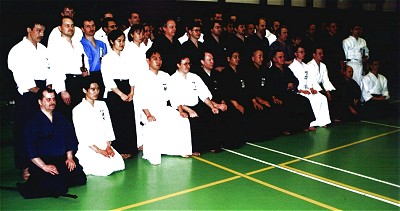
The iaido seminar was taught by Oda sensei and Furiuchi sensei, assisted by some of their students. (Nakakura sensei didn't attend this year, I heard he had a bad encounter with a stair).
I originally planned to use different typeface to distinguish between what was actually said, what was shown, and my own comments, but I decided that this would create an unwarranted impression of objectivity. It's probably better that everything below is considered as my subjective opinion. Oda sensei read from his notes while Furiuchi sensei demonstrated, and the two didn't always agree. It should also be mentioned that the iaido seminar was not acoustically isolated from the Nakakura cup, so we didn't hear everything that was said due to the kendo noise.
Technical points
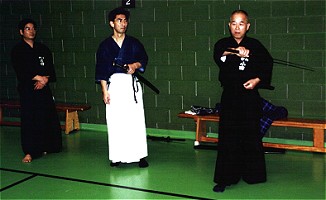
The big "change" this year was nukitsuke. It was explained that nukitsuke ends with the shoulders at an angle of 45 degrees, with the arm at the same angle. What was shown, however, was completely different; at the end of nukitsuke the arm (and the sword) points straight forward, the wrist completely bent, tsuka touching the forearm (B on the drawing). At first I thought this was exaggerated to demonstrate the difference with the demonstrated wrong way (marked A on the figure), however, several members of the club reported being corrected for not bending their wrist sufficiently.

The figure marked C shows my previous understanding of nukitsuke (the second step is drawn exaggerated). In this nukitsuke you can actually cut (with the sword at a cutting rather than chopping angle) using the muscles of the back rather than relying on wrist flicks, and cutting with the monouchi instead of just the kissaki. It also keeps the wrist straighter, which is a stronger position, probably more healthy, and it conforms better to the rules of shodo (sword and brush being one), not to mention tennis. In my opinion, this extremely bent wrist thing is one of those points that will be gone or changed by next year. Also, more often than not the bent wrist nukitsuke seemed to end as in figure D, thereby losing control over the opponent. Presumably the weak wrist position makes a clean stop impossible. Perhaps we should all start using those ultralight iaitos so we can do flashy wrist techniques too.

proper cutting angle, by Toriyama sensei
On furikaburi, don't forget the stab towards the ear, don't lower the tip and strike immediately once the left hand reaches the tsuka. the cut ends with the tip only slightly lowered (seems less than was usual). Also, the sword must now be horizontal and not 45 degrees up in furikaburi (according to Furiuchi's students).
The last move of chiburi must be made directly without first changing (f.e. raising) the sword's position. Keep hips on the same level during ashisabaki and maintain seme.
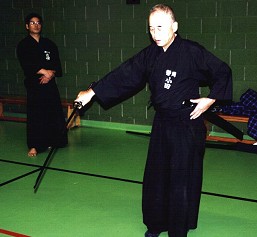
Noto starts at the tsuba (they said, but Furiuchi did Omori ryu noto all the time)
In ushiro, take care that the left foot is not placed too far to the left.
Ukenagashi starts with the opponent sitting. Metsuke is to the eyes of the attacker. The left foot is not placed as far as the knee (somewhat closer). Twisting the body is the important point. The wrist remains in the same position during the twist. Deflection is on the shinogi. The right foot points straight forward. The cut ends below the groin, lower than we were used to.
Hakamasabaki seems to be optional. It was pointed out that the sword and the shoulders should remain directed to the front while sitting down. For tsukaate the right foot should not be placed too far to the right. The stab is to the suigetsu (the sword lowers somewhat during the tsuki, from nipple height to almost elbow level). Check the result of the tsuki before looking forward again. During noto the right foot must be kept behind the knee.
The hips and upper body should not move during the cuts in kesagiri. The hand should not be brought back too far, it should stay before the body. Cut at once. The cut ends a bit lower here too. Hasso appears to be done with the left hand a bit more to the right of the centre line.
Morotetsuki: the nukitsuki here should also be a flick of the wrist instead of a real cut (it was observed that Oda didn't bend his wrist anything near as much as Furiuchi in the few moves he demonstrated). In the chudan position, the left foot must remain behind the right. During the stab the arms are extended farther than we were used too (there is even some bending forward). Raising the sword while turning should be done close to the body and with the tip moving in a vertical plane. Apparently we are to step first and cut later, rather than at the same time.

Sanpogiri: last year there was a big fuss that the left foot should keep pointing straight forward during the first cut. Apparently this was now forgotten, as it was neither mentioned nor observed. Between the first and second cut the tip should move in a vertical plane. It was said that the third cut must happen more quickly (directly contradicting Ishido sensei last August).
Ganmenate: atemi is somewhat above the point between the eyes (?) One should keep looking until the opponent drops. Sayabiki by turning the hips, the mune must remain in contact with the body. Tsuki to the suigetsu, so the extension of the tsuka would just touch the body (the right hand not too far in or out). Raising the sword and cutting with the tip moving in a vertical plane.
Soetetsuki: first cut ends at navel height. The left foot is straight, not in hanmi. While withdrawing the foot, the body should not move backwards, don't bend the left leg. During the tsuki the heel must be off the ground. Tsuki is almost horizontal, not to the suigetsu.
The most important difference (from our practice) in shiogiri is that the hand is not placed on top of the tsuka as per jodo gyakute uchi during the atemi. Probably our practice is somewhat contaminated by jodo-practicing sensei such as Ishido Shizufumi. The tsuki is in the direction of the shoulder (Furiuchi's stab extends his hand beyond the left arm). For the fourth opponent the sword is raised in ukenagashi (tip down). For wakigamae, the tip is lowered during the body turn, not before. This is a normal turn, ending with the left foot turned towards the enemy. Remember to keep the hands in contact with the body.
General remarks
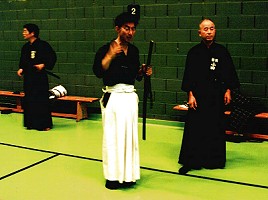
this guy in front was the interpreter
The left hand should be completely on the tsuka, a bit of the tsuka protrudes from the left hand.
Metsuke is too low for everybody, we should look a bit higher.
In finishing torei de sageo must be pulled loose before the left hand takes the tsuba. Furiuchi pulls his sageo, passes it to his left hand before taking his tsuba, then passes it again to his right before pulling the sword from the obi, instead of dropping it, and picking it up once the right hand holds the tsuba. His way eliminates the large move with the left hand (see photo below, the guy in the white hakama) which I think is a good thing.
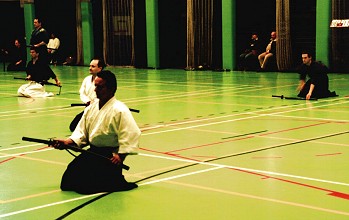
In the beginning torei the right hand remains on the tsuka until the left finished with the sageo. The back and neck must be kept straight during the bow. No adjustment to the position of the sword in the obi is allowed after the sageo is tied.
